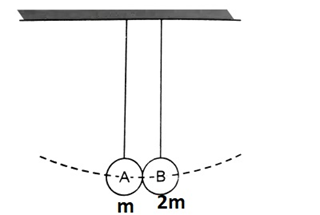
Two pendulum bobs of mass m and 2m collide elastically at the lowest point in their motion. If both the balls are released from height H above the lowest point. The velocity of the bob of mass m just after collision will be:
A. \[\sqrt{\dfrac{2gH}{3}}\]
B. \[\dfrac{5}{3}\sqrt{2gH}\]
C. \[\sqrt{2gH}\]
D. None of the above
Answer
559.5k+ views
Hint: The bobs are released from a common height H. Both these will gain some velocity while coming down. These velocities can be found using conservation of mechanical energy. Now the balls will collide elastically and head on. There is no external force present in the horizontal direction, so we can apply the conservation of momentum in the horizontal direction. it is also given that the collision is elastic. That means the coefficient of restitution is 1 and the formula is given below.
Formula used:
\[e=\dfrac{-\left( {{v}_{2}}-{{v}_{1}} \right)}{{{u}_{2}}-{{u}_{1}}}\]
Complete answer:
The bobs are released from a common height H. Both these will gain some velocity while coming down. Let's find these velocities.

From conservation of mechanical energy
\[\begin{align}
& \dfrac{1}{2}m{{u}^{2}}=mgH \\
& \Rightarrow u=\sqrt{2gH} \\
\end{align}\]
As the mass term is getting cancelled out both the bobs will have same velocities at the lowest point before the collision
\[{{u}_{m}}={{u}_{2m}}=\sqrt{2gH}=u\]
Now the balls will collide elastically and head on. There is no external force present in the horizontal direction, so we can apply the conservation of momentum in the horizontal direction.
\[mu-2mu=-m{{v}_{m}}+2m{{v}_{2m}}\]
\[\Rightarrow -u=-{{v}_{m}}+2{{v}_{2m}}\]……..…(1)
Now it is also given that the collision is elastic. That means the coefficient of restitution is 1
We know that coefficient of restitution is given as
\[e=\dfrac{-\left( {{v}_{2}}-{{v}_{1}} \right)}{{{u}_{2}}-{{u}_{1}}}\]
Plugin in the values
\[e=\dfrac{-(-{{v}_{m}}-{{v}_{2m}})}{(u+u)}\] and \[e=1\]
\[\Rightarrow 1=\dfrac{-(-{{v}_{m}}-{{v}_{2m}})}{(u+u)}\]
\[\Rightarrow 2u={{v}_{m}}+{{v}_{2m}}\]………(2)
Adding (1) and (2) we get
\[\begin{align}
& u=3{{v}_{2m}} \\
& \Rightarrow {{v}_{2m}}=\dfrac{u}{3} \\
\end{align}\]
Putting in the value of \[{{v}_{2m}}\] in (2) we get
\[{{v}_{m}}=\dfrac{5u}{3}\]
Now plugin in the value of u as calculated above
\[\begin{align}
& {{v}_{m}}=\dfrac{5u}{3} \\
& \Rightarrow {{v}_{m}}=\dfrac{5}{3}\sqrt{2gH} \\
\end{align}\]
So, the velocity of the bob of mass m just after collision will be \[\dfrac{5}{3}\sqrt{2gH}\]
So, the correct answer is “Option B”.
Note:
Here we applied the law of conservation of momentum and coefficient of momentum to get the values of velocities. But to save time there is a direct formula that can give the velocity after Collision and has been derived from these two principles only. The formula goes as follows
\[{{v}_{1}}=\left( \dfrac{{{m}_{1}}-{{m}_{2}}}{{{m}_{1}}+{{m}_{2}}} \right)\times {{u}_{1}}+\left( \dfrac{2{{m}_{2}}}{{{m}_{1}}+{{m}_{2}}} \right)\times {{u}_{2}}\]
Formula used:
\[e=\dfrac{-\left( {{v}_{2}}-{{v}_{1}} \right)}{{{u}_{2}}-{{u}_{1}}}\]
Complete answer:
The bobs are released from a common height H. Both these will gain some velocity while coming down. Let's find these velocities.

From conservation of mechanical energy
\[\begin{align}
& \dfrac{1}{2}m{{u}^{2}}=mgH \\
& \Rightarrow u=\sqrt{2gH} \\
\end{align}\]
As the mass term is getting cancelled out both the bobs will have same velocities at the lowest point before the collision
\[{{u}_{m}}={{u}_{2m}}=\sqrt{2gH}=u\]
Now the balls will collide elastically and head on. There is no external force present in the horizontal direction, so we can apply the conservation of momentum in the horizontal direction.
\[mu-2mu=-m{{v}_{m}}+2m{{v}_{2m}}\]
\[\Rightarrow -u=-{{v}_{m}}+2{{v}_{2m}}\]……..…(1)
Now it is also given that the collision is elastic. That means the coefficient of restitution is 1
We know that coefficient of restitution is given as
\[e=\dfrac{-\left( {{v}_{2}}-{{v}_{1}} \right)}{{{u}_{2}}-{{u}_{1}}}\]
Plugin in the values
\[e=\dfrac{-(-{{v}_{m}}-{{v}_{2m}})}{(u+u)}\] and \[e=1\]
\[\Rightarrow 1=\dfrac{-(-{{v}_{m}}-{{v}_{2m}})}{(u+u)}\]
\[\Rightarrow 2u={{v}_{m}}+{{v}_{2m}}\]………(2)
Adding (1) and (2) we get
\[\begin{align}
& u=3{{v}_{2m}} \\
& \Rightarrow {{v}_{2m}}=\dfrac{u}{3} \\
\end{align}\]
Putting in the value of \[{{v}_{2m}}\] in (2) we get
\[{{v}_{m}}=\dfrac{5u}{3}\]
Now plugin in the value of u as calculated above
\[\begin{align}
& {{v}_{m}}=\dfrac{5u}{3} \\
& \Rightarrow {{v}_{m}}=\dfrac{5}{3}\sqrt{2gH} \\
\end{align}\]
So, the velocity of the bob of mass m just after collision will be \[\dfrac{5}{3}\sqrt{2gH}\]
So, the correct answer is “Option B”.
Note:
Here we applied the law of conservation of momentum and coefficient of momentum to get the values of velocities. But to save time there is a direct formula that can give the velocity after Collision and has been derived from these two principles only. The formula goes as follows
\[{{v}_{1}}=\left( \dfrac{{{m}_{1}}-{{m}_{2}}}{{{m}_{1}}+{{m}_{2}}} \right)\times {{u}_{1}}+\left( \dfrac{2{{m}_{2}}}{{{m}_{1}}+{{m}_{2}}} \right)\times {{u}_{2}}\]
Recently Updated Pages
Master Class 11 Economics: Engaging Questions & Answers for Success

Master Class 11 English: Engaging Questions & Answers for Success

Master Class 11 Social Science: Engaging Questions & Answers for Success

Master Class 11 Biology: Engaging Questions & Answers for Success

Class 11 Question and Answer - Your Ultimate Solutions Guide

Master Class 11 Business Studies: Engaging Questions & Answers for Success

Trending doubts
What is meant by exothermic and endothermic reactions class 11 chemistry CBSE

10 examples of friction in our daily life

One Metric ton is equal to kg A 10000 B 1000 C 100 class 11 physics CBSE

Difference Between Prokaryotic Cells and Eukaryotic Cells

What are Quantum numbers Explain the quantum number class 11 chemistry CBSE

1 Quintal is equal to a 110 kg b 10 kg c 100kg d 1000 class 11 physics CBSE




